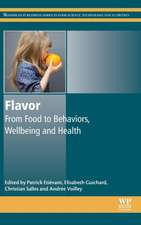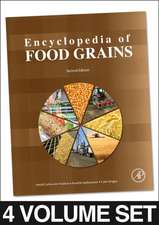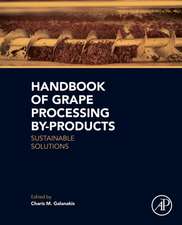Integrating the Packaging and Product Experience in Food and Beverages: A Road-Map to Consumer Satisfaction: Woodhead Publishing Series in Food Science, Technology and Nutrition
Editat de Peter Burgessen Limba Engleză Hardback – 4 apr 2016
For fast-moving consumer goods (FMCG) products in particular, packaging can be considered as a contributor to consumer satisfaction. Recent cross-modal research illustrated consumers’ dissatisfaction or delight with a product can be evoked when there is dissonance between the packaging and the product experience.
The book includes an extensive overview of an adapted satisfaction scale that has been tailored for the food and beverage sector and which identifies varying satisfaction response modes such as contentment, pleasure, and delight with a product. This is an important development as it provides insights about products that can be used to market specific categories and brands of foods and beverages.
The book demonstrates the value of this approach by bringing together case studies that consider the interrelationships between packaging design, shape, on-pack sensory messages, expectations, and consumer satisfaction with the product.
- Focuses on the inter-relationship between packaging and the product experience, specifically in the context of the food and beverage sector
- Presents the expectancy disconfirmation model of satisfaction, which is well developed within the social sciences, to the food and beverage sector
- Contains case studies demonstrating how these practices can be used in industry to better enhance customer’s responses to products
- Includes an extensive overview of an adapted satisfaction scale that has been tailored for the food and beverage sector and which identifies varying satisfaction response modes such as contentment, pleasure, and delight with a product
Din seria Woodhead Publishing Series in Food Science, Technology and Nutrition
- 15%
 Preț: 391.19 lei
Preț: 391.19 lei - 24%
 Preț: 1333.02 lei
Preț: 1333.02 lei - 24%
 Preț: 1210.03 lei
Preț: 1210.03 lei - 24%
 Preț: 946.43 lei
Preț: 946.43 lei - 9%
 Preț: 1205.99 lei
Preț: 1205.99 lei - 24%
 Preț: 1189.10 lei
Preț: 1189.10 lei - 9%
 Preț: 984.09 lei
Preț: 984.09 lei - 9%
 Preț: 1006.66 lei
Preț: 1006.66 lei - 24%
 Preț: 960.56 lei
Preț: 960.56 lei - 23%
 Preț: 1419.50 lei
Preț: 1419.50 lei - 9%
 Preț: 1206.85 lei
Preț: 1206.85 lei - 9%
 Preț: 922.07 lei
Preț: 922.07 lei - 24%
 Preț: 1192.22 lei
Preț: 1192.22 lei - 9%
 Preț: 1215.75 lei
Preț: 1215.75 lei - 24%
 Preț: 1162.37 lei
Preț: 1162.37 lei - 9%
 Preț: 950.09 lei
Preț: 950.09 lei - 24%
 Preț: 1162.62 lei
Preț: 1162.62 lei - 24%
 Preț: 801.31 lei
Preț: 801.31 lei - 27%
 Preț: 379.84 lei
Preț: 379.84 lei - 29%
 Preț: 1336.07 lei
Preț: 1336.07 lei - 24%
 Preț: 798.74 lei
Preț: 798.74 lei - 9%
 Preț: 1018.93 lei
Preț: 1018.93 lei - 24%
 Preț: 1081.43 lei
Preț: 1081.43 lei - 24%
 Preț: 1185.22 lei
Preț: 1185.22 lei - 31%
 Preț: 922.77 lei
Preț: 922.77 lei - 24%
 Preț: 1131.77 lei
Preț: 1131.77 lei - 23%
 Preț: 1635.86 lei
Preț: 1635.86 lei - 9%
 Preț: 1277.62 lei
Preț: 1277.62 lei - 24%
 Preț: 1049.04 lei
Preț: 1049.04 lei - 24%
 Preț: 1134.60 lei
Preț: 1134.60 lei - 9%
 Preț: 1076.36 lei
Preț: 1076.36 lei - 24%
 Preț: 1158.21 lei
Preț: 1158.21 lei - 9%
 Preț: 1065.06 lei
Preț: 1065.06 lei - 9%
 Preț: 1067.39 lei
Preț: 1067.39 lei - 24%
 Preț: 812.03 lei
Preț: 812.03 lei - 9%
 Preț: 1203.13 lei
Preț: 1203.13 lei - 23%
 Preț: 1237.19 lei
Preț: 1237.19 lei - 24%
 Preț: 948.79 lei
Preț: 948.79 lei - 23%
 Preț: 1138.06 lei
Preț: 1138.06 lei - 9%
 Preț: 868.43 lei
Preț: 868.43 lei - 24%
 Preț: 871.98 lei
Preț: 871.98 lei - 20%
 Preț: 1272.59 lei
Preț: 1272.59 lei - 29%
 Preț: 1195.06 lei
Preț: 1195.06 lei - 9%
 Preț: 1045.58 lei
Preț: 1045.58 lei - 9%
 Preț: 1002.45 lei
Preț: 1002.45 lei - 9%
 Preț: 1062.13 lei
Preț: 1062.13 lei - 24%
 Preț: 1306.94 lei
Preț: 1306.94 lei
Preț: 505.72 lei
Preț vechi: 555.74 lei
-9% Nou
Puncte Express: 759
Preț estimativ în valută:
96.80€ • 105.18$ • 81.36£
96.80€ • 105.18$ • 81.36£
Carte tipărită la comandă
Livrare economică 14-28 aprilie
Preluare comenzi: 021 569.72.76
Specificații
ISBN-13: 9780081003565
ISBN-10: 0081003560
Pagini: 220
Dimensiuni: 152 x 229 x 18 mm
Greutate: 0.52 kg
Editura: ELSEVIER SCIENCE
Seria Woodhead Publishing Series in Food Science, Technology and Nutrition
ISBN-10: 0081003560
Pagini: 220
Dimensiuni: 152 x 229 x 18 mm
Greutate: 0.52 kg
Editura: ELSEVIER SCIENCE
Seria Woodhead Publishing Series in Food Science, Technology and Nutrition
Cuprins
1. Consumers' mind set - Expectations, experience and satisfaction
2. Shape, color and texture - Cross-modal applications of packaging design
3. Emotions - Packaging evoked emotional responses
4. Consumers’ perceptions of new/novel packaging technologies
5. Methods for consumer experience assessment of sensory characteristics and packaging design
6. Industry case studies
7. Conclusions
2. Shape, color and texture - Cross-modal applications of packaging design
3. Emotions - Packaging evoked emotional responses
4. Consumers’ perceptions of new/novel packaging technologies
5. Methods for consumer experience assessment of sensory characteristics and packaging design
6. Industry case studies
7. Conclusions























